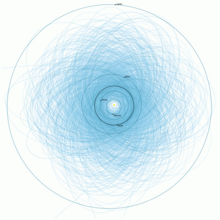Sentry (monitoring system)
Since 2002, Sentry has been a highly automated collision monitoring system that continually scans the most current asteroid catalog for possibilities of future impact with Earth over the next 100+ years.[1] Whenever a potential impact is detected it will be analyzed and the results immediately published on the Near Earth Object Program.[1] However, several weeks of optical data are not enough to conclusively identify an impact years in the future.[2] By contrast, eliminating an entry on the risk page is a negative prediction; a prediction of where it will not be.[2] Scientists warn against worrying about the possibility of impact with an object based on only a few weeks of optical data that show a possible Earth encounter years from now.[2]
Sentry Risk Table

The Impact Risk page lists a number of lost objects that are, for all practical purposes, permanent residents of the risk page; their removal may depend upon a serendipitous rediscovery.[3] 1997 XR2 was serendipitously rediscovered in 2006 after being lost for more than 8 years. Some objects on the Sentry Risk Table, such as 2000 SG344, might even be man-made.
Notable objects currently on the risk page include (numbered asteroids listed first): (29075) 1950 DA, 99942 Apophis, 101955 Bennu, 2009 FD, 1994 WR12, and 2010 RF12.[1] Notable asteroids removed from Sentry in the last few years include (most recently removed listed first): 2007 VK184, 2013 BP73, 2008 CK70, 2013 TV135, 2011 BT15, 367943 Duende, and 2011 AG5.
The diameter of most near-Earth asteroids that have not been studied by radar or infrared can generally only be estimated within about a factor of 2 based on the asteroid's absolute magnitude (H).[1] Their mass, consequently, is uncertain by about a factor of 10. For near-Earth asteroids without a well-determined diameter, Sentry assumes a generic albedo of 0.15. More than two dozen known asteroids have higher than a one in a million chance of impacting into Earth within the next 100 years.[4]
In August 2013, the Sentry Risk Table started using planetary ephemeris (DE431) for all NEO orbit determinations.[5] DE431 (JPL small-body perturber ephemeris: SB431-BIG16) better models the gravitational perturbations of the planets and includes the 16 most massive main-belt asteroids.[5]
JPL launched major changes to the website in February 2017 and re-directed the classic page on 10 April 2017.
As of February 2017[update] there are roughly 680 near-Earth asteroids listed on the risk table[1] and roughly 2000 asteroids have been removed from the risk table since it launched in 2002.[6]
References
- ^ a b c d e "Sentry Risk Table". NASA/JPL Near-Earth Object Program Office. Retrieved 2017-04-13.
- ^ a b c Jon Giorgini (30 July 2002). "Understanding Risk Pages". Columbine, Inc. (hohmanntransfer). Retrieved 2011-11-21.
- ^ "IMPACT RISK ASSESSMENT: AN INTRODUCTION". NASA/JPL Near-Earth Object Program Office. 31 Aug 2005. Retrieved 2011-10-14.
- ^ Donald K. Yeomans (9 February 2013). "Beware of Errant Asteroids". New York Times. Retrieved 10 February 2013.
{{cite web}}: External link in|author= - ^ a b "Sentry Notes". NASA/JPL Near-Earth Object Program Office. 2013-08-12. Retrieved 2017-04-13.
- ^ "Removed Objects". NASA/JPL Near-Earth Object Program Office. Archived from the original on 2017-02-25. Retrieved 2017-02-16.
{{cite web}}: Unknown parameter|deadurl=ignored (|url-status=suggested) (help)
